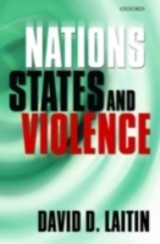Details

Nations, States, and Violence
|
59,99 € |
|
| Verlag: | OUP Oxford |
| Format: | |
| Veröffentl.: | 26.07.2007 |
| ISBN/EAN: | 9780191527883 |
| Sprache: | englisch |
| Anzahl Seiten: | 180 |
DRM-geschütztes eBook, Sie benötigen z.B. Adobe Digital Editions und eine Adobe ID zum Lesen.
Beschreibungen
Nations, States, and Violence presents a revisionist view of the sources of nationalism, the relationship of the nation to culture, and the implications of nationalism and cultural heterogeneity for the future of the nation-state. It accepts the now-standard view that national identities are not inherited traits but constructed communities in order to serve political ends. But the resulting national identities do not emerge from some metaphorical plebisciteas had been suggested by some; rather they result from efforts by people to coordinate their identities with people who share at least some cultural traits with them. Coordination leads to powerful social and cultural ties that are hard to unravel, and this explains the persistence of national identities. Understood as the result of coordination dynamics, the implications of national homogeneity and heterogeneity are explored. The book shows that national heterogeneity is not, as it is sometimes accused of being, a source of hatred and r s1ence. Nonetheless, there are advantages to homogeneity for the production of public goods and economic growth. Whatever the positive implications of homogeneity, the book shows that in the current world, classic nation-states are defunct. Heterogeneity isproliferating not only due to migration but also because small groups in many states once thought to be homogeneous are coordinating to demand national recognition. With the prohibitive costs of eliminating cultural heterogeneity, citizens and leaders need to learn how best to manage, or even takeadvantage of, national diversity within their countries. Management of diversity demands that we understand the coordination aspects of national heterogeneity, a perspective that this book provides. In addition to providing a powerful theory of coordination and cultural diversity, the book provides a host of engaging vignettes of Somalia, Spain, Estonia, and Nigeria, where the author has conducted original field research. The result is a book where theory is combined with interpretations of current issues on nationalism, economic growth, and ethnic violence.














